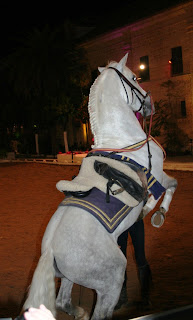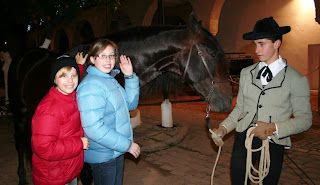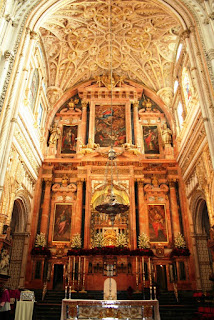In late January we had a blast of real winter which finally put an end to the cool but not at all unpleasant dry sunny days of December and early January. With some areas experiencing unprecedented early spring flowering, recent reports suggest that this winter has been the mildest since records began some 350 years ago. This of course follows last winter, which was the coldest and driest in 100 years. William took a photo of this crocus which flowered in our garden in middle of January. The short post on the snow SNOW POST let you know that the kids had flown out to go skiing just before the first snow fell. A few days before their return we had a 2nd snowfall, while not quite as heavy as the first, it ensured there was snow in the garden for the kids to see. Mind you, they had seen quite a bit of snow but were still excited to see snow here.
 |
| A spring crocus in January. |
 |
| The clear dry though cool days of Dec +Jan. |
We also had a grown up night at home eating baked salmon with no arguments over having to eat fish. We went to a Soul & Blues concert in the crypt at St Martin's in the Field church. We saw the local band Miss Hoodoo and the Delta boys who, with a substitute Miss Hoodoo, gave us two hours of classic Blues Brothers and Aretha Franklin style music. Jazz in the Crypt
Mark went on his own to the National Gallery and saw numerous Van Goghs, including sunflowers, various Monets, some Renoirs, a couple of Michelangelos (just unfinished ones though), several Degas, a clutch of Rubens and some other stuff too.
We were also able to get to see 'The Artist ' at our local theatre The Phoenix, an independent theatre opened in 1912 and the 2nd oldest continuously running theatre in the UK. The Phoenix
We were also able to get to see 'The Artist ' at our local theatre The Phoenix, an independent theatre opened in 1912 and the 2nd oldest continuously running theatre in the UK. The Phoenix
While we were away in Spain, Sally's uncle Dick and Aunty Joan came to the UK, ultimately on their way to Namibia. Dick & Joan were the only friends or family who visited us while we were in Jakarta in 1997 - 2000. They landed on our doorstep in 1997 not too long after we arrived on posting. They had several months backpacking through the Indonesian archipelago by the time they reached us. In retirement they have both made numerous independent adventure style trips around the world proving that the late 60s are indeed the new 20s.
They have stayed with us in the Blue Mountains in Sydney as well as here just after we returned from Spain. The weekend we had them coincided with Aisha having one friend and William having two friends to stay over. Four adults and five kids made for a full house and we all enjoyed Mark's 'Daddio's' pizza for dinner and homemade chuross con chocolate for breakfast the next day. To work off the Churros we all went out to the local park and had a hit around on the tennis courts.
William received a 1,000 piece puzzle from his Uncle Chris (Sally's brother) and, in true Worsfold style, neither Sally nor Dick could resist 'helping'. William did get to have a go though.

 |
| Daddio's pizza for dinner. |

 |
| Chuross con for everyone in the land ! |


Uncle Dick, now a retired geologist, emigrated from the UK to Canada in the late 1960s. Before that he spent two years stationed at Antarctica in the early 1960s. He has numerous stories of sledding across ice bridges, falling down chasms and having to eat his own eyebrows in order to survive. Eating his own eyebrows may have been an exaggeration though. What is certain is that he named a mountain range - The Worsfold/ Jellet Range whose co-ordinates are: Latitude 75° 6'22.96"S Longitude 12°46'49.52"W. He originally wanted to name the range Nunky ( uncle ) Rocks after his newly born first niece Sally. Sadly this name was not allowed so eternal fame eluded our Sal. Aunty Joan is a teacher and a fluent Spanish speaker as well as a good tennis player and musician. Joan helped Aisha with her Spanish, William with his guitar and gave him a run for his money at our local tennis courts.
"In 1950 I had my arse smacked by Harry Strutt for nicking the sugar-cubes from the cafe. Christ yeah, I remember Harry Strutt."
Even more bizarrely it seems that the same week that we went to the Minnack theatre in Penzance this couple had also seen the production of Hamlet two days before we did.
We saw Dick & Joan off safely from the wilds of East Finchley with their next stop being South Africa to catch up with the friends mentioned above and then drive themselves to Namibia. As you do. At the time of posting this we think they are still there, somewhere, in Namibia.
In late January we resumed our British adventures with a long weekend in Dover. The second week after going back to school the kids had a pupil free day. Mark and the kids drove down to Dover and Sally joined them by train on the Friday evening. It was the beginning of the really cold and windy weather that would last for a couple of weeks and lead eventually to the snow of early February.
As with so much of England, the Dover castle site, sitting as it does on top of the White Cliffs, was probably fortified before the 2nd Roman invasion of 43 AD. The site has been of strategic navigational importance since the time of the Romans, who built upon the existing Iron age fort adding two lighthouses, one of which still stands. William the Conqueror attacked the fort that stood there in 1066, this was eventually rebuilt by Henry II, then Henry VIII added to it, it was captured by the Parliamentarians during the civil war and so on.
It was during the Napoleonic wars at the end of the 18th century that the castle was heavily reinforced with underground barracks and storerooms added 15 meters below the cliff top as fears loomed that the French would invade.
They didn't, but the tunnels that were to be eventually abandoned would play a key role much later in another defense of Britain from possible invasion. The artillery tracking and communications rooms behind and beneath the chalk cliffs have been left as they were after WWII. The miles of tunnels under the castle were put to use for the preparation for the evacuations from Dunkirk in France, operation Dynamo, and then to help keep track of what was going on over the channel during the war. Sally's Grandpa was on the gun ship 'Arethusa' which took the King to observe evacuations, so visiting here was very special for her. Interestingly, during the cold war the tunnels were recommissioned and prepared for use as a possible seat of regional government in the event of a nuclear attack.....
Parts of the castle interiors have been presented much as they would have during during Henry II's time. The colours are apparently accurate and were used to show the wealth of the owner. Blue was derived from crushed Lapis Lazuli which, then as now, was only found in Afghanistan, while the red used gold. The small beds reflect the fact that it was considered unhealthy to sleep laying down as the devil might assume you were dead and take your soul. People therefore tended to sleep sitting up so a long bed was not required.


We went to see nearby Sandwich, famed for its 18th century 4th Earl, John Monatgu, who, desiring to keep his fingers clean whilst eating beef and playing cards, brought about the development of the sandwich. Sandwich has other claims to fame, which you can read below. It was interesting and unusual to see the amount of bilingual signage in this part of S.E England.
As with so much of England, the Dover castle site, sitting as it does on top of the White Cliffs, was probably fortified before the 2nd Roman invasion of 43 AD. The site has been of strategic navigational importance since the time of the Romans, who built upon the existing Iron age fort adding two lighthouses, one of which still stands. William the Conqueror attacked the fort that stood there in 1066, this was eventually rebuilt by Henry II, then Henry VIII added to it, it was captured by the Parliamentarians during the civil war and so on.
It was during the Napoleonic wars at the end of the 18th century that the castle was heavily reinforced with underground barracks and storerooms added 15 meters below the cliff top as fears loomed that the French would invade.
 |
| The French are coming !!! We could actually see the French coast. |
 |
| The WWII communications room. |
They didn't, but the tunnels that were to be eventually abandoned would play a key role much later in another defense of Britain from possible invasion. The artillery tracking and communications rooms behind and beneath the chalk cliffs have been left as they were after WWII. The miles of tunnels under the castle were put to use for the preparation for the evacuations from Dunkirk in France, operation Dynamo, and then to help keep track of what was going on over the channel during the war. Sally's Grandpa was on the gun ship 'Arethusa' which took the King to observe evacuations, so visiting here was very special for her. Interestingly, during the cold war the tunnels were recommissioned and prepared for use as a possible seat of regional government in the event of a nuclear attack.....
 |
| Aisha is not impressed by the little bed. |
Parts of the castle interiors have been presented much as they would have during during Henry II's time. The colours are apparently accurate and were used to show the wealth of the owner. Blue was derived from crushed Lapis Lazuli which, then as now, was only found in Afghanistan, while the red used gold. The small beds reflect the fact that it was considered unhealthy to sleep laying down as the devil might assume you were dead and take your soul. People therefore tended to sleep sitting up so a long bed was not required.


We went to see nearby Sandwich, famed for its 18th century 4th Earl, John Monatgu, who, desiring to keep his fingers clean whilst eating beef and playing cards, brought about the development of the sandwich. Sandwich has other claims to fame, which you can read below. It was interesting and unusual to see the amount of bilingual signage in this part of S.E England.

As a port town, Sandwich was granted in 1028 the right by King Canute, no less, to operate a ferry and control and taxing river freight. Mark really enjoyed the effect the toll bridge has on 21st century motorised vehicular traffic......



Sandwich was also where Tom Paine lived for several years. An inventor, author and radical he was involved in labor reform movements in the UK. He met Benjamin Franklin on London and, on his recommendation, headed to America just in time to take part in the American war of Independence. Through his inspirational writing, Paine became one of the founding fathers of the United Sates, helping shape the American constitution. So influential were his ideas that John Adams, 2nd U.S president, reportedly said "without the pen of the author..... the sword of Washington would have been lifted in vain."

The kids were overjoyed when we finished off the Dover area with a visit to yet ANOTHER castle, this time Deal Castle. Quite different to most others we have seen, this flower shaped castle sat squat and solid just off the beach at Deal. Henry VIII ordered a series of similar coastal castles to be built as defense against the annoying Catholics of Span and France.
Work started on the castle in 1539 and was all but complete 12 months later. The castle was built in the shape of a Tudor rose with low rounded walls designed to deflect cannon balls. There were over 200 gun and cannon ports and the whole structure is surrounded by an impressively wide and deep moat.
Anne of Cleaves, the German girl whom Henry VIII fell in love with and married on the basis of a possibly overly generous portrait, apparently stayed at Deal Castle on her way to meet Henry in late 1839.



This part of the Kent coast, most likely nearby Walmer, is where Emperor Julius Caesar landed in 54 & 55 BC. He reportedly attempted to land at Dover but was prevented by massed locals perched up on the White Cliffs. The closeness of the cliffs to the beach meant that the Britons could easily have rained down spears onto the Romans if they had landed there. They may also have had to deal with local youths throwing stones !
From Dover we visited the nearby Richborough fort. The Roman invasions all landed somewhere on the north coast of Kent. The Romans had their eye on Britain for some time. Julius Caesar's two invasions had mixed success. Later, Emperor Augustus planned further invasions in 34, 27 & 25 BC but each was called off, usually because the Empire needed to Strike Back at rebels elsewhere. Caligula planned an invasion in 40BC, reportedly drawing the troops into battle formation on the French coast facing Britain only to order them to attack the standing water then collect seashells. Sounds far preferable to fighting !
 |
| The Richborough fort wall. |
 |
| A section of the fort walls 2,000 year old Roman brick coming loose. |
 |
| Original Roman Samian pottery found at Richborough. |
Richborough, which was known as Rutupiae by the Romans, seems to be the site where they landed in their 2nd major invasion of Britain by Claudius in 43AD. At this time the coast was around 2 miles farther inland than it is now and the river by the fort was much wider. In the centre of Richborough fort sits the foundations of the once 25 metre high, Italian marble clad triumphal arch built to commemorate the final conquest of Britain. Around the arch, and the fort as a whole, large defensive trenches were dug. Again we found ourselves nonchalantly interacting with global history with the kids playing in these 2,000 year old structures.
 |
| The foundations of the arch surrounded by defensive trenches. |

The arch marks the most likely beginnings of what was to become Wattling Street, the Roman road to London and then on to Chester leading eventually up to Scotland. As with many things, the Romans took what was already in existence, modified them and claimed them as their own. Wattling Street followed the existing grassed walkways used by the native Britons. The Romans paved and straightened the route. Large parts of Wattling Street now lay beneath existing modern British motorways including the A2 between Dover and London. In central London Edgware Road and Maida Vale road follow Roman roads.
 |
| Roman Roads. |

At the end of February we are all well and enjoying some more unseasonably warm weather. The small camellia in our back garden has been in flower now for a couple of weeks, much earlier than it should be.
As S.E Australia sees the end of an apparently very mild & fairly damp summer, south east England is now officially in drought and the Brits are being advised on how to save water. Sounds familiar !
Our neighbours blame us for bringing the drought !!.
The next blog will be on Chester, our recent snowfalls and the kids' ski trip to France and should be up by about the end of the first week of March.


.JPG)













































































